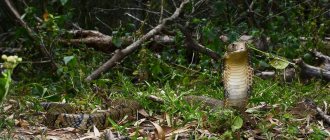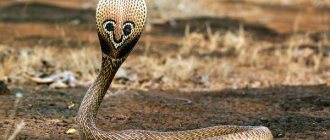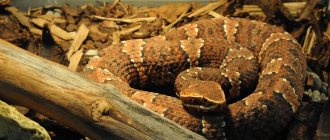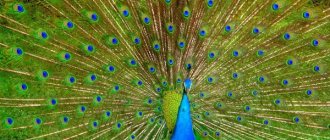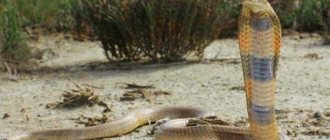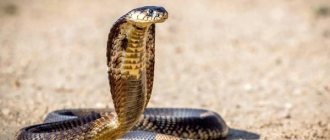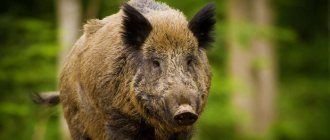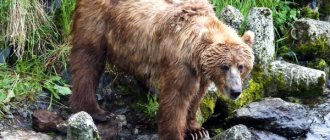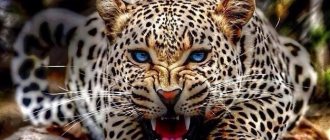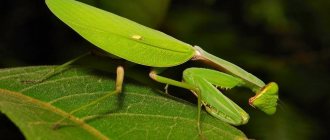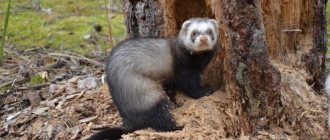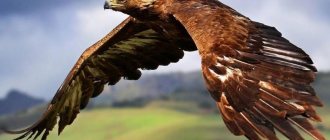The spectacled cobra belongs to the genus of “real” cobras. In Hinduism it is considered sacred. It can be seen among snake charmers in India. According to the description, this is a dangerous poisonous snake. A cobra's bite is fatal.
Every year in India, 45-50 thousand people die from snake bites
In India, more than 46,000 people die every year from snakebites. The spectacled cobra is one of the 4 snakes that bite the most people: the sea snake, Russell's viper, scaly viper and Indian cobra.
Spectacled cobra - history of the origin of the species and name, classification
A snake from the genus true cobras, the family of asps, has several names:
- Spectacled cobra,
- Spectacled snake,
- Indian cobra.
The scientific name of the species is Naja-naja.
In its habitats, the indigenous people call this cobra: naya, nag, murkan, nagu pamu. Table 1 – Brief information
| Name | Spectacled cobra |
| Scientific name | Naja naja |
| Other names | Spectacled snake, South Asian cobra |
| View | Cobras |
| Genus | Real cobras |
| Family | Poisonous |
| Class | Reptiles |
| Color | Brown gray |
| Length | Up to 1.7 m |
| Origin | Asia |
| Habitat | Forests, rice fields |
| Toxicity | Very poisonous |
| Danger | One spectacled snake accounts for up to 5,000 human deaths per year |
The word “spectacled” was given to the snake due to the pattern on its hood. It consists of 2 black circles. Each circle is outlined in white.
The spectacled snake's hood looks like a hood.
An Indian legend is associated with the unusual design. Residents of India believe that these “glasses” are a gift from Buddha. One day a snake covered the sun with its hood. With this she protected Buddha from the scorching rays. He decided to thank all the spectacled snakes. The special pattern was his gift. This design both decorates and protects the snakes.
When studying the species, its subspecies changed many times. In the 19th century there was a species naja-naja and 10 subspecies. Then 4 Indian subspecies became independent. And new representatives have been added to the spectacled cobra.
The following subspecies of Indian cobra are now distinguished:
- Central Asian,
- Blind,
- monocle,
- Taiwanese,
- Spitting Indian.
Description
The Indian cobra is a fairly large snake, with a body up to two meters long, covered with dense scales. A distinctive feature of this type of snake is the hood, which the cobra opens in case of danger or excitement. The hood causes swelling of the body of the Indian cobra, formed as a result of the expansion of the ribs and intercostal muscles.
Indian cobras are distinguished by a variety of body surface colors . More often the scales are yellow, grayish-brown or sandy in color. Close to the head there is a pattern, the contours of which resemble glasses, for which the cobra is called a spectacled snake. The drawing performs a protective function. When attacking it, it seems to the predator that the snake is looking directly at him, and not with his back turned.
Spectacled cobra - anatomical features
The spectacled cobra can reach a length of 2 m. On average, specimens from 1.2 to 1.7 m are found.
The cobra's body is slender and covered with smooth scales. The tail ends with a pointed tip. The head is round in shape with large scutes. The eyes are small, with round pupils.
Color
The upper body includes all shades of brown. The skin can be dark gray or fiery yellow. There are bright spots on the back. Usually they are combined into fuzzy transverse stripes. The color depends on the geographical region of the cobra. Black specimens are found in Pakistan. In such species, the characteristic pattern is not noticeable.
Skin color varies depending on region of residence
The color of the belly depends on the color of the back. It varies from milky white, yellowish to gray with and without dark spots. Monocular spectacled albino cobra.
The monocle cobra is one of the most fascinating species of snakes
The cubs have more pronounced stripes across the body. With age they become less noticeable.
Distinctive feature
There is a design on the back of the neck shield. These are 2 circles connected by a line. Reminds me of glasses. This is a well-known variation. There may be more circles or none at all. For example, the monocle cobra subspecies has one eyepiece.
Among cobras there are snakes that have one eyepiece in the appliqué
Cobra hoods are inflated with special ribs. They only rise when the snake is in an aggressive mood. The signs on the back of the hood are protective equipment. If the snake's enemy approaches from behind, it freezes. The pattern confuses him. When the cobra is not disturbed, its hood rests on its head.
A 4-meter cobra will rise almost 1.5 meters above the ground.
Teeth
The two venomous fangs are 7.5 mm long. These are the longest teeth among cobras in Asia. The remaining teeth are small and non-venomous.
How to behave when meeting a snake if it has bitten
Even with a broken tooth, a snake can bite. Broken or pulled out poisonous teeth are replaced with new ones.
Interesting! Not all spectacled cobras have devices for spitting venom. For example, the naja oxiana subspecies does not have them. But all cobras spit venom.
The spitting cobra has very high accuracy.
Indian cobras have good accuracy. They never miss. Even from a great distance they can get into the victim's eyes.
The spectacled cobra (Naja naja (LINNAEUS, 1758)) is the taxonomic parent of almost all Asian cobras; previously, many of the independent species were just subspecies of the spectacled cobra; there are no examples of a more striking reorganization of the species than the history of studying the systematics of the spectacled cobra. Back in the 19th century there was only one species - Naja naja with 10 subspecies, four of which were found in India: Naja naja naja - Indian subspecies with glasses on the hood; Naja naja kaouthia - cobras with one ring on the hood; Naja naja oxiana (Central Asian cobra); Naja naja sagittifera (Andaman cobra). Thanks to the Indian herpetologist Deraniyagala (1945, 1960, 1961), all four subspecies acquired independent status, and new subspecies for Naja naja were identified: Naja naja indusi in northwestern India, they are “characterized” by the absence of ordinary teeth on the maxillary bone, although normally there should be one; Naja naja madrasiensis in the south, their poisonous teeth were thought to be morphologically sufficiently developed for spitting; Naja naja gangetica in northeast India, a subspecies without any basis, even in the original article; Naja naja bombaya - central India, identified from a single find, distinguished by the absence of “cuneate” scales; Naja naja karachiensis - southern Pakisat and adjacent areas of India. The population of spectacled cobras from Sri Lanka was considered to be the nominative form of Naja naja naja, but all of Deraniyagala’s arguments were not weighty enough, and many of his works were subsequently ignored by his colleagues. In 1984, a temporary subspecies Naja naja polyocellata appeared, which even Deraniyagala called only a special Sri Lankan variation, but not a subspecies, later they decided so.
Now everything is different, but there are studies of cladists, according to which one of the most famous snakes is more basal than other species. All this is very important in fact, especially for poisonous snakes, as it turns out, each species has its own toxicology, all differ greatly in the effect and strength of the poison, the fight against the consequences of bites varies depending on the type of cobra. Quite a few people died from the generalization of all Asian cobras into one species; it is enough to mix up the serums. Studying the taxonomy of venomous snakes leads to optimization of the process of producing antivenom serums. lives in the following countries: Pakistan, India (in most of the country), Myanmar, Sri Lanka, Bangladesh, Nepal, Bhutan, eastern Afghanistan. In India, it is one of the four deadliest snakes, including epha (Echis carinatus), bungar (Bungarus caeruleus) and chain viper (Daboia russeli), we can safely say that this is one of the most dangerous snakes in the world, although not so poisonous like taipans, up to 10,000 deaths from the venom of spectacled cobras are recorded per year.
This is a large snake, often reaching two meters (record holders from Sri Lanka), usual sizes 100-150 cm (newborns 25-30 cm), very powerful body, easy to distinguish from other types of cobras by the spectacled pattern on a very large hood, however, This sign is very variable. The standard option is when there are two black spots (their width is two scales) on the back with a light edging, but there may be more spots, or they may be completely absent. The color can also be different, there are yellow, gray, reddish and completely black snakes with light white markings, there are also natural melanists, sometimes they are classified as a separate subspecies Naja naja karachiensis - Pakistani black cobra, last published under this name in 2013, most recently , everyone still remembers the works of the famous Indian herpetologist; by the way, in the Pakistani population of spectacled cobras, the babies are colored gray, and the hood does not always have glasses from birth. Why are Pakistani cobras not a separate subspecies? In fact, according to the signs, everything is in order, if you wish, you can calculate the pattern in the number of scales, the color is special, more than anything, but there is not enough isolation from other spectacled cobras, so it all depends on herpetologists, some elevate this point to a fundamental one, others ignore it, It is worth noting that not all subspecies of snakes are necessarily characterized by isolation; hybrids are simply recognized at the border of populations. Let's return to the characteristics of Naja naja. The population from Sri Lanka can have up to 20 transverse black stripes on the belly, normally there should be 1-5, the very position of the large “throat” collar is also variable, the error can reach up to 10 scales. The number of rows of dorsal scales in spectacled cobras is very variable, it all depends on the population, in the northwest the number of rows is less, and there are populations with such a large number of dorsal rows that no other Asian cobra has. They can be distinguished from the closest monocle cobras by the presence of one small triangular “interlabial” (cuneate) scale above the fifth lower labial, or between the fourth and fifth, and again, just don’t get angry, however, there are spectacled cobras without these scales, I wrote above about the subspecies Naja naja bombaya, it is not recognized, because many spectacled cobras with a “cuneate” were subsequently found from its habitats, a feature classified within the limits of individual variability. The range of spectacled cobras overlaps with many other former subspecies, the differences are always minimal, most often taxonomists are guided by the pattern on the hood, the color on the ventral side and the isolation of some species from others, because the number of abdominal, dorsal, and caudal scales overlaps greatly for different species, given the variability of the spectacled cobra cobras
The length of poisonous teeth can reach 7.5 mm, spectacled cobras have the longest teeth relative to body size among cobras throughout Asia, in addition to poisonous fangs there are also non-venomous teeth, spectacled cobras usually have one non-venomous tooth on the maxillary bone, but sometimes this rule is not works, and there is no dependence on certain populations, everything is within the limits of individual variability, chaotic, for this reason they refused to distinguish the subspecies Naja naja indusi and Naja naja bombaya. In 1% of cobras, two teeth were found on the maxillary bone. An interesting detail: almost all cobras can spit venom, to varying degrees, of course, but Naja naja and Naja oxiana have no devices for this at all. For the above reasons, studying the behavior of spectacled cobras, their lifestyle, diet, the action of poison and much more turned out to be difficult, because in old publications there is not always a description of the morphology and there are no high-quality images of the objects of study, one has to guess about which of the 10 species of the “spectacled cobra complex” " was discussed, but the types are completely different. Now imagine, the most famous snake in the world, due to an incredible number of errors by morphologists and herpetologists, was not studied until 1998! Spectacled cobras have spread so widely for a reason; they can occupy a variety of niches; they are found everywhere, from tropical forests to rice fields, in arid places, they are often seen near settlements, they move well through water and climb well at low heights. In terms of diet, everything is also very universal, most of it consists of rats and other small rodents, followed in equal numbers by tailless amphibians, lizards (even monitor lizards), snakes, including poisonous snakes, such as ephas. They have time to learn everything and go everywhere thanks to round-the-clock activity; they prefer evening and night time, but can be active during the day. From April to July, spectacled cobras lay eggs, there can be up to 45 eggs in a clutch, usually less, females remain to guard the nest until the babies hatch, incubation lasts 48-69 days. An interesting fact: hybrids of monocle cobras and spectacled cobras are characterized by the protection of clutches in pairs; males also participate in this process.
Everyone knows how cobras defend themselves, the spectacled ones are better than all others in this regard, and all thanks to the hood of record sizes, relative to the body, of course. If threatened, snakes take a characteristic stance on a third of the body, hiss loudly and make throws towards the irritant, it is extremely rare that everything comes to a bite, usually these are head blows, if bites do occur, they are not always fatal; when defending, spectacled cobras use little poison, and sometimes it is not injected at all. Let me remind you that this species cannot spit; all publications on this subject were due to confusion with other species, former subspecies of Naja naja.
The venom of spectacled cobras is complex, it includes a postsynaptic neurotoxin and a cardiotoxin; when bitten, muscle paralysis occurs, breathing stops, and the heartbeat is disrupted. Hyaluronidase in cobra venom is capable of increasing the permeability of tissues by reducing the viscosity of the mucopolysaccharides included in their composition, this leads to necrosis and accelerated spread of the venom throughout the victim’s body. Symptoms begin within the first 15 minutes, and in special cases appear after two hours. For mice LD50 (“venom strength”) is 0.45 mg/kg–0.80 mg/kg, I remind you that the lower this value, the stronger the poison, for the taipan the same figure is around 0.03 mg/kg, for Blanding’s boiga 2.88 mg/kg. On average, a spectacled cobra injects 169-250 mg of venom per bite. If serum was used during this time, there is a high probability of complete recovery after a full bite, the probability of death is 15-20%.
I do not recommend keeping it in captivity, but if it so happens that there is a cobra, it is worth considering the following. Juveniles can be kept in small 10-liter plastic containers; adults require a large terrarium, large enough to allow the snake to move around in it, to provide shelter (with a moist substrate inside, such as moss), a drinking bowl, and to provide the necessary temperature gradient. , from 24 to 28 background, at a point up to 33 (day 12 hours), at night you can drop to 22-24, wintering 16-20 degrees for two months a year, the photoperiod is reduced. To be honest, adult spectacled cobras are successfully kept and bred in plastic containers with a volume of about 100 liters; no wintering or playing with light is carried out. Of course good ventilation is necessary. Suitable substrates include mulch, shavings, coconut substrate, coconut chips, pine chips, paper, newspaper, and napkins. Lighting doesn't matter. Humidity is 60%; spraying is necessary only during molting. The diet in captivity can consist of only rats, do not overdo it, obesity is very dangerous for all snakes.
Synonyms for spectacled cobra in different areas of its range: nag, murkan, naya, nagu pamu, nagara havu, naga pambu, nalla pambu, fetigom, gohra. In the future, the consolidation of the Albino morph of the spectacled cobra, hypomelanists and other interesting variations are already known, everything is still ahead, there is every chance to catch up with the monocle.
Always remember about special safety precautions when working with venomous snakes; all information on this subject is presented on our forum. Thank you very much for your attention))) There will be more to come
Spectacled cobra: character traits and lifestyle
Cobras are shy by nature. Most often they try to avoid people. These snakes would rather hide or crawl away than fight. If a snake crawls away, it does so slowly. At the same time, he does not take his eyes off the enemy.
But when provoked, cobras are hostile. If the snake is threatened, it assumes its characteristic pose. The cobra raises the front third of its body. It then extends its long, flexible neck ribs with loose skin to form its famous hood.
The spectacled cobra can be active both day and night. Mostly crawls on the ground. But it can climb high ground well. Especially if it is necessary for lodging or food.
Enemies in nature
Cobras, in turn, can become a delicacy for monitor lizards, snake eagles,
wild boars (on which cobra venom has no effect). Sometimes cobras can eat each other, or rather cobras of other species, so the largest king cobra hunts its relatives of other species. The most active enemies of the cobra are meerkats and mongooses, which defeat snakes due to their agility and intelligence.
This video captures the epic battle between a mongoose and a cobra.
Where does the Indian snake live?
The spectacled snake is found throughout the Indian subcontinent. Regions of her residence:
- from the southern Himalayas,
- West Pakistan,
- India,
- Nepal
- to Sri Lanka and Bangladesh.
Central Asia, Southern China, the islands of the Malay Archipelago, the Philippines - individuals of this species are also found here.
The Indian cobra can live even in the mountains
Indian cobras have been recorded even in mountainous areas. They climb to a height of 2700 m above sea level.
Cobra lives in humid mid-mountain and lowland forests near water. Often found in rice fields. Here snakes find good food for themselves: rodents. Dangerous snakes also appear near human habitats. They can be found in granaries, piles of rocks, landfills or buildings overgrown with bushes.
First aid for a bite
If you are bitten by a cobra, you should never:
- apply a tourniquet,
- cauterize the wound
- make cuts
- cover the bite site with cotton wool soaked in potassium permanganate,
- drink alcohol.
And you need to do the following:
- suck out the poison from the wound in the first 20 minutes after the bite,
- try to determine the type of snake, if it was killed, then take it with you for analysis,
- record the exact time of the bite,
- treat the wound with an antiseptic, alcohol, its solution, or at least soapy water,
- apply a sterile bandage to the bite site, immobilize the affected part of the body, giving it an elevated position;
- if the victim has impaired upper breathing, it is necessary to correct it, otherwise he will suffocate;
- and rush to the hospital as quickly as possible.
What does a snake eat?
The spectacled snake is a predator. She hunts various rodents, birds, amphibians and reptiles. Most often its prey is:
- Mice,
- lizards,
- frogs,
- mongooses,
- bird eggs.
Occasionally it may attack another snake.
The cobra attacks the victim and quickly bites. Then he waits for the poison to take effect. The toxin damages the victim's nervous system, paralyzing and killing him. The spectacled cobra then swallows its prey whole.
In search of rodents, this species enters buildings
CONTENT
- 1 Taxonomy
- 2 Description 2.1 Scaling
- 2.2 Similar species
- 6.1 Synteny analysis
- 7.1 Hinduism
Spectacled cobra - how does it reproduce?
Mating of the Indian cobra occurs in January-February. At the end of spring, the female lays eggs. Typically 10 to 20 eggs are laid. Very rarely the number of eggs exceeds the average. Heaps of fallen leaves, depressions in the ground, hollows, and abandoned termite mounds are selected for laying. Spectacled cobras are responsible “parents”. They do not leave the future cubs until they are born. The clutch is always guarded by one of a pair of snakes.
A month after mating, the king cobra gives birth to offspring
The size of the small snake is 35-40 mm.
Incubation lasts 60-70 days. After the appearance, the baby snakes immediately become independent. But they are in no hurry to leave the clutch and remain in the shell for some time. They are poisonous from birth. Small insects are eaten first. As they develop and mature, young cobras move on to larger prey.
Video
And in conclusion, we invite you to watch the interesting documentary “The Mysteries of the King Cobra.”
Author: Pavel Chaika, editor-in-chief of Poznavaika magazine
When writing the article, I tried to make it as interesting, useful and high-quality as possible. I would be grateful for any feedback and constructive criticism in the form of comments on the article. You can also write your wish/question/suggestion to my email [email protected] or Facebook, with respect, the author.
Author page
Indian cobra bite
All cobras are intelligent. They give clear warnings before they bite a person. These are the so-called “dry bites”. This is usually the first bite. And it is not life threatening. The cobra either strikes with its mouth closed or injects a small amount of venom.
If you don’t manage to get away from the snake in time, or worse, anger the snake, then there will be a full-fledged bite with a sufficient amount of poison.
The bite of a spectacled cobra is dangerous. But, according to herpetologists, instant death after such a bite never occurs. A person has a chance to survive. Only every 5th bite is fatal. And then, if no attempts were made to rescue.
A.V. Ognev, herpetologist, naturalist
The venom of the Indian cobra contains substances that damage the nervous system.
An interesting feature of spectacled snakes in the Philippines. They are capable of releasing poison at a distance of up to 3 m.
Links[edit]
- ^ a b "Naja nazha". Encyclopedia of Life
. Retrieved March 28, 2014. - ^ a b » Naja nazha » . Integrated Taxonomic Information System. Retrieved March 23, 2014.
- Uetz, P. "Naja naja". Reptile Database
. Retrieved March 28, 2014. - ^ abc Whitaker, Romulus; Captain, Ashok (2004). Snakes of India: A Field Guide
. Chennai, India: Draco Books. ISBN 81-901873-0-9. - Mukherjee, Ashis K. (2012). "Green Medicine as a Harmonizing Tool of Antivenom Therapy for the Clinical Treatment of Snakebite: The Path Ahead". Indian J Med Res
.
136
(1):10–12. PMC 3461710. PMID 22885258. - "Naja". Free dictionary
. Princeton University. Retrieved March 28, 2014. - "Naja". Integrated Taxonomic Information System. Retrieved March 29, 2014.
- Linnaeus, Karl (1758). Systema naturae per regna tria naturae: classes secundum, ordines, genera, species, cum characteribus, differentials, synonyms, locis (in Latin) (10th ed.). Stockholm: Lavrentiy Salvius.
- Wuster, W. (1996). Naja naja
species complex )".
Toxicon
.
34
(4): 399–406. DOI: 10.1016/0041-0101 (95) 00139-5. PMID 8735239. - Smith, M. A. (1943). Reptiles and Amphibians, Volume 3: Snakes
. Fauna of British India, Ceylon and Burma, including the entire Indochinese subregion. London, England: Taylor and Francis. pp. 427–436. - ^ abcd Daniel, J. C. (2002). Book of Indian Reptiles and Amphibians
. Oxford, England: Bombay Natural History Society and Oxford University Press. pp. 136–140. ISBN 0-19-566099-4. - ^ abc Wüster, W. (1998). "Cobras of the genus Naja in India" (PDF). Hamadryad
.
23
(1):15–32. Retrieved September 15, 2014. - ^ abcdefg "Nadja nazha" . University of Adelaide
. - Mahendra, British Columbia. (1984). Directory of Snakes of India, Ceylon, Burma, Bangladesh and Pakistan
. Agra: Academy of Zoology. item 412. - ^ ab Whitaker, Captain, Romulus, Ashok (2004). Snakes of India, A Field Guide
. India: Draco Books. p. 354. ISBN 81-901873-0-9. - Achyuthan, K. E.; Ramachandran, L.K. (1981). "Indian cobra (Naja naja) cardiotoxin is a pyrophosphatase" (PDF). Journal of Biological Sciences
.
3
(2): 149–156. DOI: 10.1007/BF02702658. S2CID 1185952. - "IMMEDIATE FIRST AID for Indian or common cobra (Naja naja naja) bites". Archived from the original on 2012-04-02.
- "LD50". Sean Thomas and Eugene Grissel - December 1999;
Australian Poisons and Toxins Database . University of Queensland. Archived from the original on February 1, 2012. Retrieved December 1, 2011. - ^ a b Brown Ph.D., John H. (1973). Toxicology and pharmacology of venoms from poisonous snakes. Springfield, IL, USA: Charles S. Thomas Publishing. paragraph 81. ISBN 0-398-02808-7.
- World Health Organization. "Zoonoses Control: A Baseline Epidemiological Study on the Treatment and Management of Snakebites." Weekly Epidemiological Summary
.
62
(42): 319–320. ISSN 0049-8114. - ↑
Snakebites: A Growing Global Threat. BBC News (22 February 2011). Retrieved January 3, 2013. - Martz, W. (1992). "Plants with a Reputation for Anti-Snakebite." Toxicon
.
30
(10): 1131–1142. DOI: 10.1016/0041-0101 (92) 90429-9. PMID 1440620. - Daduang; Sattayasai, N.; Sattayasai, J.; Tophrom, P.; Thammathaworn, A.; Chaveerach, A.; Konkchaiyaphum, M. (2005). "Screening of plants containing inhibitory activity against cobra venom Naja naja siamensis
using a modified ELISA method."
Analytical Biochemistry
.
341
(2):316–325. DOI: 10.1016/j.ab.2005.03.037. PMID 15907878. - Katshu, MZUH; Dubey, I.; Hess, C.R.J.; Sarhel, S. (2011). "Snake bite as a new form of substance abuse: Personality profiles and cultural perspectives". Substance abuse
.
32
(1):43–46. DOI: 10.1080/08897077.2011.540482. PMID 21302184. - ↑
Rodrigo, M. (October 9, 2016) Homemade antidote trial to begin. sundaytimes.lk - Singh, L (1972). "Evolution of karyotypes in snakes". Chromosome
.
38
: 185–236. - ^ abcdefghijk Suryamohan, Kushal; Krishnankutty, Sajesh P.; Guillory, Joseph; Jewitt, Matthew; Schröder, Markus S.; Wu, Maine; Kuriakose, Boni; Matthew, Oommen K.; Perumal, Rajadurai C.; Koludarov, Ivan; Goldstein, Leonard D. (2020). "Indian Cobra Reference Genome and Transcriptome Allows Comprehensive Identification of Venom Toxins". Genetics of Nature
.
52
(1): 106–117. DOI: 10.1038/s41588-019-0559-8. ISSN 1546-1718. The text has been copied from this source, which is available under a Creative Commons Attribution 4.0 International License. - Gutierrez, Jose Maria; Calvete, Juan J.; Habib, Abdulrazaq G.; Harrison, Robert A.; Williams, David J.; Worrell, David A. (September 14, 2022). "Snake bite poisoning". Nature Reviews Primers for Diseases
.
3
(1): 1-21. DOI: 10.1038/nrdp.2017.63. ISSN 2056-676X. - Myths about snakes. wildlifesos.com
- Prevention of Cruelty to Animals Act 1960. indialawinfo.com
- Heraldry of Madhya Pradesh. hubert-herald.nl
Spectacled Cobra Venom
The spectacled snake has a strong neurotoxin. It is a poison that acts on the nervous system in the area of tiny gaps between nerve endings, nerves and muscles.
Cobra venom causes respiratory arrest 2-6 hours after the bite.
1 gram of poison can kill more than 100 medium-sized dogs.
Venom apparatus and venom composition
The Indian cobra's venom spitting is different from that of other snakes. The poison is squeezed out of the glands by the muscles of the upper jaw directly into the mouth. To do this, the snake makes chewing movements. She then blows the venom out through a hole in her lower jaw. Through this gap the snakes stick out their tongues.
A dose of 15-17 mg is lethal for an adult. On average, a cobra injects 16-25 mg of venom per bite.
As is the case with the venom of many cobras, the venom of this species also has proportions that can destroy tissue. This leads to poorly healing wounds or even necrosis.
Composition of the poison:
- postsynaptic neurotoxin,
- cardiotoxin,
- hyaluronidase.
Tip #1 . If you are going to visit an area where the spectacled cobra lives, you need to prepare. Walking should be done only in high shoes with hard soles. Try to avoid large grass and crevices. It is better to take a stick with you and carefully tap the path in front of you.
Spectacled cobra - how the poison acts on the human body
The following symptoms should be expected after a full blown bite:
- instant severe pain in the bite area,
- paralysis. At first there may be numbness of the lips, eyelids, impaired vision and swallowing. Then comes speech impairment up to paralysis of the entire body, associated with life-threatening respiratory paralysis. The latter can occur even after 17 hours.
- Severe swelling in the bite area.
- Tissue necrosis.
- Diarrhea,
- Vomit,
- Nausea,
- Abdominal pain,
- Dizziness,
- Intense thirst
- Loss of consciousness,
- State of shock.
Table 2 - First aid for bites
| Antidote | First aid | Forecasts |
| There are different serums. They are effective against the neurotoxic venom of the spectacled snake. But they have little effect on local symptoms. You can survive a bite without an antidote. Provided that during the toxic effect of the poison, artificial ventilation is available. | The general rules that apply to any snake bite also apply in this case: 1. Stay calm, both physical and psychological. 2. If possible, identify the snake. 3. Transport the bitten person in a lying position. 4. Provide the patient with qualified assistance as quickly as possible. 5. Do not rely on naturopathic therapy (use of spells, snake stones, etc.). This is ineffective and wastes time in providing professional assistance. | Whether a person survives or not depends on the amount of poison injected and the condition of the person bitten. If a lot of poison was received and medical assistance could not be provided quickly. The result can be disastrous. And in the best case, poorly healing wounds occur at the site of the bite. |
After injecting cobra venom, a chicken dies in 4 minutes, a laboratory mouse in 2 minutes.
Important! Injecting serum can always be dangerous for allergy sufferers. Because it can cause life-threatening anaphylactic shock. Therefore, the use of antivenom should always be supervised by an experienced physician or other specialist.
Population and species status
The total number of these reptiles is steadily decreasing from year to year. The greatest damage to populations is caused by people who absolutely thoughtlessly interfere with the living space of the king cobra. These reptiles are caught in order to obtain snake venom, a rather valuable raw material for pharmaceuticals and cosmetology. In addition, an antidote is made from cobra venom that can neutralize the effect of snake venom after a bite. Cobra venom is also used in the manufacture of various painkillers, as well as other types of drugs that can cure a person from various ailments. The industry produces various cosmetics that have a rejuvenating effect on human skin. Since the value of cobra venom is very high, this living creature suffers from this, often at the cost of its life.
In some Asian countries, cobra meat is considered a delicacy. In addition, a variety of dishes are prepared from cobra meat using various technologies. It’s not hard to imagine how much such meat costs and how profitable the business can be. The Chinese eat literally everything, including the skin of the king cobra, and also drink its fresh blood. In Laos, they came up with a whole ritual involving eating cobra.
Important point! In Laos they believe that by eating cobra meat, a person becomes stronger, more courageous, and his body gains a healthy spirit and he becomes wiser.
Cobras are also hunted for their rather valuable skin, from which various fashion accessories are made. In addition to the fact that cobra leather has a unique pattern and original texture, it is strong and durable. All kinds of accessories, in the form of handbags, belts, purses, shoes, etc., cost a lot of money. It is therefore not surprising that poaching is rampant in some countries.
The actions of humans, who annually occupy larger and larger territories inhabited by these unique, albeit dangerous, living creatures, are considered especially dangerous in relation to the king cobra. As a result, reptiles have to look for new territories. The fact is that as a result of the construction of roads, railways and simply deforestation, the food supply of the king cobra also suffers, so it has to look for territories with a food supply. The result is a vicious circle, since all flora and fauna suffer, which can lead to very disastrous consequences.
It is not at all surprising that many representatives of flora and fauna are on the verge of complete extinction and the king cobra is no exception. Environmental organizations have given the cobra the status of vulnerable.
Spectacled cobra: features of keeping in captivity
Poisonous snakes are not recommended to be kept in a terrarium. It is clear what danger they pose. Although caring for a cobra itself does not require special conditions.
For young individuals, tanks with a volume of 10 liters are suitable. These can be small plastic containers. For an adult cobra, the volume of the terrarium should be 100 liters. That is, sufficient for the snake to move freely in it.
Necessary elements for arranging a terrarium:
- shelter with a damp substrate (for example, moss),
- drinking bowl,
- Any substrate is suitable, as for many other snakes: mulch, coconut chips, pine chips, shavings.
Cobras love moisture. Therefore, the humidity level should be maintained at 60%. Temperature is also important. During the day, the suitable temperature is 24-28˚С, at night it should be reduced to 22-24˚С.
You can feed mice and rats. But you should not overfeed. Obesity is dangerous for a snake.
Tip #2. Before you bring a poisonous snake into your home, you should think things through. When kept in a terrarium, you will have to have close contact with a dangerous animal: clean the cage, feed it.
Nutrition
What does a cobra eat? Cobras, like other snakes, are predators; the main source of their diet is various small animals:
frogs, small rodents, lizards, other smaller snakes. Cobras also love to feast on bird eggs and newly hatched chicks. Some species of cobras do not disdain to eat carrion.
Answers and questions
Does the spectacled cobra live in Russia?
Spectacled cobras do not live in Russia.
In some countries of the former USSR, a rare subspecies is found: the Central Asian cobra naja oxiana. In Tajikistan, Turkmenistan and Uzbekistan, this species is protected in nature reserves.
Is it possible to avoid being bitten by a spectacled cobra?
It's possible. The spectacled cobra swallows its prey whole. The person is of no interest to her in this regard. That's why cobras rarely attack people. You need to carefully leave the place where you encounter a poisonous snake. You shouldn't shout or hit the cobra. This will only make her angry. Then the bite cannot be avoided.
External links [edit]
| Wikimedia Commons has media related to Naja Naya . |
- Snakes in Indian Culture Article on the Biodiversity of India website.
| Taxon identifiers |
|
Spectacled cobras in Indian culture
Indian mythology deifies all types of snakes. But the spectacled cobra stands out as the most revered of them all. Thus, the Indian god Shiva is depicted with a protective cobra. She hugs his neck. Cobras are worshiped during various holidays. There is even a special holiday for these snakes - the Cobra Festival.
Herpetologists studied cobras after the Festival. All specimens had poisonous teeth in place. But not a single spellcaster was bitten during the holiday.
There are many myths about cobras in India. Thus, it is believed that the dead souls of people live in cobras.
Cobras are not listed as an endangered species. Although their numbers have declined due to habitat loss. Lately, it has been hunted for its distinctive markings on its hood. This leather is used in the production of bags.
Interesting Facts
- The collared cobra is considered the best actress among snakes. If intimidating methods do not help her - standing, hood, hissing and swaying, she falls to the ground with her stomach up, bares her teeth and pretends to be dead. “Don’t touch me, I’m already dead!”
- It is believed that the snake charmer, by playing the flute, lulls the snake's attention, as if hypnotizing it. She sways in unison with the swaying of a person, as if dancing to music. In fact, these snakes are deaf. They carefully monitor the musician’s smallest movements, moving regularly themselves. Moreover, it is the monotony of their own swaying that calms the snake so much that some spellcasters even effectively kiss the “actress” at the end.
- Removal of teeth from caster cobras is uncommon. Of course, it is safer to work with this snake, but it does not live long. She dies of hunger, and the spellcaster has to find a new artist. In addition, viewers can check the danger of the act and ask to see the poisonous teeth. Then the charlatan will fail.
- In some Indian temples, cobras, settling there, unwittingly serve as night guards. Burglars, unaware of the presence of venomous snakes, may suddenly disturb them and be bitten in the dark.
- Cobra is not often a guest in terrariums and zoos. She does not like her neighbors and is hostile in captivity.
- This crawling creature can move along the ground at speeds of up to 6 km/hour and is capable of catching up with a person, but it never does this.
Local names[edit]
Indian cobra[10][11] or spectacled cobra[4], common in South Asia, is referred to by a number of local names derived from the root Nag
(नाग) (Hindi, Marathi)(નાગ) (Gujarati),
Moorkhan
, മൂര്ഖന് (Malayalam),
Naya-නයා
or
Nagaya-නාගයා
(Sinhalese), నాగు పాము (Nagu Paamu) (Telugu), [11] ನಾಗರ ಹಾವು
Nagara Haavu
(Kannada), [11]
Nalla pambu
(நல்ல பாம்பு) or
Nagapambu
(நாகப்பாம்பு) (Tamil) [11] "Fetigom" (Assamese) and
Gohra
(গো খরো) (Bengali). "ଗୋଖର ସାପ / ନାଗ ସାପ" in (Odia)
Natural enemies of spectacled snakes
Photo: Spectacled snake in India
Despite the fact that the spectacled reptile is very poisonous, in natural conditions it has enemies who are not averse to feasting on this dangerous creeping creature. First of all, young animals, which are the most vulnerable and inexperienced, may suffer. Predatory birds such as snake eagles attack young snakes directly from the air, easily dealing with them. Monitor lizards also eat the young with pleasure. The king cobra specializes in snake snacks, so it can eat its closest relative, the Indian cobra, without a twinge of conscience.
The most notorious and reckless enemy of the Indian cobra is the brave mongoose, which does not have complete immunity to the poisonous toxin of the snake, but its body shows little sensitivity to the poison, so this predatory animal from the viverrid family very rarely dies from a reptile bite. The mongoose relies only on its resourcefulness, agility and dexterity.
The animal torments the spectacled lady with its active movements and tireless jumping. When the right moment comes, the red-haired brave man makes his crowning leap, the apogee of which is the snake’s bite in the neck or back of the head, from which the crawling one dies. Kipling immortalized the feat of the brave mongoose Riki-Tiki-Tavi in his work. But he fought there precisely with the family of Indian cobras (Nagaina and Nag). Mongooses not only kill the reptiles themselves, but often destroy their nesting sites by eating snake eggs. In addition to mongooses, meerkats also prey on the spectacled snake.
